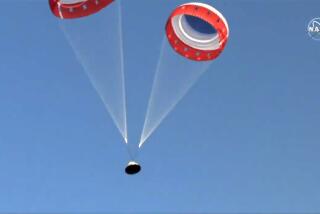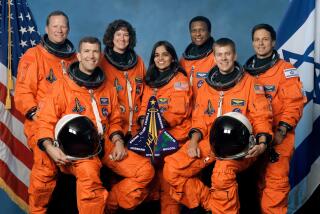The Love of Their Lives
- Share via
CLEAR LAKE, Texas — Jon Clark, an Army brat as a boy, an ambitious flight surgeon as a man, has long preferred the cold facts -- “the stats,” as he calls them -- to messy emotions. But at home, he realizes now, he was mired in an unspoken competition for his son’s love. And, like many fathers, he was losing.
“We were buddies and everything,” he said. “But I was on the sidelines. He just worshipped his mom.”
Then, just like that, she was gone.
Laurel Clark, a Navy captain and astronaut, was killed one year ago Sunday when the space shuttle Columbia ripped apart over Texas. Today, Jon, 50, and his only son, 9-year-old Iain, are partners. Death has brought them closer.
“We both lost the love of our lives,” Jon said Thursday at NASA’s Johnson Space Center in Houston. “That is our bond. And it is very special.”
It has been a year of heartbreak and regret, of endless funerals and memorials and visits to the psychologists.
Jon has met with survivors of the astronauts killed aboard the space shuttle Challenger, which exploded in 1986. Their message, he says, was clear: Don’t expect the pain to end.
Iain still feels, in a sense, betrayed, bewildered as to why his mother didn’t take his advice and just stay on Earth.
“Some days he doesn’t say much, doesn’t let a lot out,” Jon said. “There are days when I’m barely holding up myself.”
In the end, though, they have found a glimmer of optimism. As Jon has struggled with the practical realities of being a newly single parent -- Where was it that Iain had gotten his haircut all these years? -- he and his son have become, in some ways, equals.
Jon has become a reluctant crusader at NASA, where he is involved with the shuttle program, calling for reform of an inflexible culture that he believes contributed to the accident. He uses his campaign to teach Iain lessons about foresight, about mistakes and consequences.
The boy, in turn, has taught Jon a thing or two about looking beyond the stats. What the surgeon might have seen as youthful delusion -- Iain’s efforts to “fix” his mother’s death -- the father now sees as a ray of hope. Iain has suggested, among other things, building a time machine so he can warn his mother not to board the shuttle. He has attempted to create magic potions that might bring her back. He also thinks it might be a good idea to try to clone her.
“He has a tenderness and a perception that adults are not even close to understanding,” Jon said. “He is openly trying to get his arms around this, and it’s very heartening to me. What a marvelous little brain.”
When it was pointed out that Iain’s ideas are fanciful, that some things just hurt and can’t be changed, Jon offered a tired smile, as if recognizing, and now dismissing, such grown-up cynicism.
“You never know,” he said with a shrug. “I wouldn’t put it past him to build a time machine one day. Maybe he really will bring her back.”
It was a cool game, one you can only play when you’re 8 and your mom is a real-life astronaut.
“Earth to mom!” Iain would yell, galloping through the tidy brick house at the end of a cul-de-sac, the one with twin magnolias out front and a ceramic rabbit in the garden. “Space to Iain!” Laurel would reply. Iain would laugh, and mimic the static of a radio transmission, then break into a wide smile that could have been lifted right from his mother’s face.
Deep down, though, as the Columbia mission approached, it became clear that Iain did not want her on that spaceship, not now, not ever. He was sure that if she flew into space, she would not make it home.
Laurel, who was accepted into the astronauts’ corps in 1996, somehow managed to do it all, juggling her duties as a mother with those of an astronaut. It was she who planted flowers in the yard, who helped Iain with his artwork. Jon frequently worked long days. It was expected at NASA, but today he realizes that it added up to a subtle distance between him and Iain, and that it may have contributed to Iain apprehension about Laurel’s mission.
Launch day came Jan. 16, 2003.
“If you’ve ever seen a launch, it’s really remarkable,” Jon said. “Sound travels slower than light. So you see it first, just rising straight up. And then you feel it, feel the energy, in your chest.”
The crowd cheered as Columbia soared toward space. Iain wept.
“He was crying and crying,” Jon said. “He was so sad, you’d have thought he had smashed his toe. He had some sort of premonition. I really believe that. He felt like she was leaving him. Not leaving him like she was going to come back soon. Leaving him. Forever.”
It was Laurel’s first time in space. Once in orbit, she wrote to her family and friends that she was becoming personal friends with Orion, the hunter whose constellation -- particularly the three stars that form his belt -- is among the most recognizable in the night sky. She talked with Jon and Iain regularly through private videoconferences, describing her involvement in several experiments, such as a test of antibiotics in low gravity. Jon took short videos of Iain and e-mailed them to her.
“She was exuberant,” Jon said.
Iain just wanted her home.
“I want to snuggle with you in my fort,” he wrote to her in an e-mail a few days before the shuttle was scheduled to land in Florida. Jon watched him type the message slowly, searching for each letter with his index finger. “Come home soon or sooner if possible,” Iain wrote. “I miss you millions more than all the stars in the universes. I love you so much I cried last night.”
*
The morning the shuttle was expected to return, Laurel played a CD of an ancient bagpipe song to wake up the crew. The song ends: “Love sets the heart a-dreaming / Longing and dreaming for the homeland again.” The crew put away the trash -- an important step when one is preparing to descend back into gravity -- and strapped in.
Jon and Iain walked outside the Kennedy Space Center in Florida to wait with the other families for the shuttle to land. The adults were buzzing with anticipation. The seven astronauts had 12 children among them, and many of the kids were there, playing under the bleachers. The static of radio transmission echoed across the tarmac, projected by two speakers.
“Columbia. Houston.” It was NASA’s mission control, trying to talk to the crew. “We see your tire pressure messages.”
Something was wrong. Sensors aboard the shuttle indicated that its tires were failing.
Jon was not an astronaut but he was intimately familiar with how the shuttle worked, and he knew that instant that the shuttle -- which could not land safely without wheels -- was in trouble.
It was Jon who had been the voice of caution back in 1994, when Laurel applied for the astronauts’ corps. She was eight months pregnant with Iain at the time. Being an astronaut is risky business, he told his wife. People have died, he told her mother. Stop being ghoulish, he was told.
As the radio transmissions continued, the rest of the crowd continued to celebrate. Within minutes, NASA reported that it had lost contact with the crew. Television reports began streaming in to the space center, showing pieces of the craft streaming across the sky.
NASA cut the transmission. At 41 years old, Laurel was dead.
“I didn’t want her to go,” Iain told his father not long after the accident. “She went anyway. And now I don’t have a mom.”
*
Flipping channels one recent day, Iain came across a program about the accident. It focused on a NASA safety engineer who had warned during the mission that a piece of foam insulation that fell from an external fuel tank might have harmed the shuttle. The engineer sent an e-mail to his colleagues saying that NASA was treating tough questions about safety like “the plague.”
Investigators later determined that the insulation, initially discarded as a potential problem, ripped the wing and allowed superheated gas to penetrate and destroy the craft.
“Why didn’t they listen?” Iain asked his father.
“I told him that it’s like when your teacher tells you not to do something, and then something bad happens because you didn’t listen,” Jon said. “NASA was like a child that didn’t listen. It was a very poignant reminder for him. It’s important to listen. You don’t have to make the mistake to see the consequences. You can think about things that might happen instead.”
This weekend will bring another round of memorials and ceremonies. The astronauts are expected to be honored during Sunday’s Super Bowl in Houston. On Monday, a memorial to the crew will be dedicated at Arlington National Cemetery -- where Laurel is buried -- next to a similar Challenger memorial.
Jon is planning to head to the dense, shady woods of East Texas.
It was there that some of Laurel’s belongings fell from the sky -- a piece of a James Taylor CD, a soot-covered medallion from the University of Wisconsin, where she received her medical degree. He still hasn’t decided whether to take Iain along. Best, perhaps, to leave him with relatives, to leave him unaware of the significance of anniversaries for now.
“It’s a tough time,” he said. “I just don’t know. Maybe next year.”
More to Read
Sign up for Essential California
The most important California stories and recommendations in your inbox every morning.
You may occasionally receive promotional content from the Los Angeles Times.











